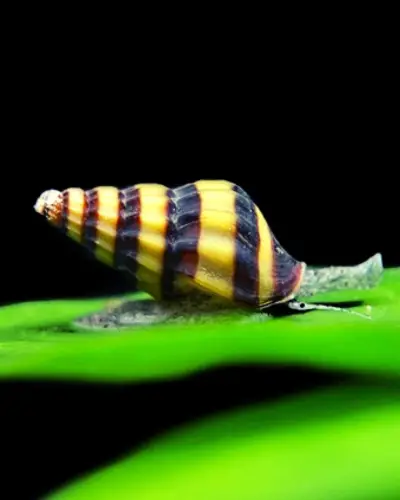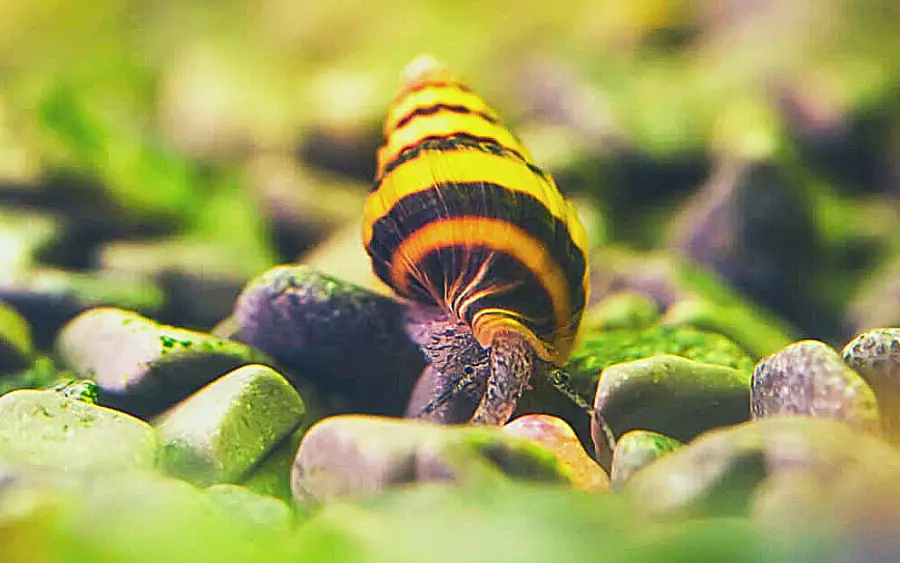Assassin snails, also known as Clea Helena, are popular with aquarium enthusiasts due to their unique yellow and dark brown appearance. These small snails are commonly used to control pest snail populations in fish tanks. But what is the perfect Assassin snail temperature range to keep them healthy?
However, one key factor that can significantly impact the health and behavior of assassin snails is the temperature of their environment.
This article will delve into the intricacies of assassin snail temperature requirements and provide expert advice on ensuring these fascinating creatures thrive in your aquarium.

From the ideal temperature range to the potential consequences of exposing them to extreme temperatures, we will cover everything you need to know to create the perfect habitat for your Assassin Snail Freshwater Ornamental Snail.
Whether you are a seasoned aquarium hobbyist or a beginner looking to add these captivating snails to your community tank, this comprehensive guide will help you understand the importance of maintaining the right temperature for your Clea Helena.
Table of Contents
ToggleOptimal Assassin Snail Temperature Range
What temperature can assassin snails tolerate? The ideal temperature range for assassin snails is 68-75 degrees Fahrenheit. It is crucial to provide a stable and consistent temperature to ensure the health and longevity of these freshwater snails.

Additionally, a warmer temperature can promote breeding among the snail population. However, it is essential to avoid temperatures that are too high, as this can decrease oxygen levels in the water, harming the snails.
When setting up a tank for assassin snails, it is crucial to consider the tank size, water parameters, and tank mates. These snails prefer a substrate that allows them to burrow, such as sand or fine gravel.
In terms of tank mates, assassin snails are compatible with most fish and other snail species but may prey on smaller snails and shrimp. It is crucial to monitor the snail population to prevent any unwanted pest snails from taking over the tank.
Are Assassin Snails Hardy?
Yes, assassin snails anentome helena are known to be quite hardy and can adapt well to various tank conditions. They are often used to control populations of unwanted snails, such as pond snails and ramshorn snails.
Assassin snails will eat other snails, with or without an operculum, as well as snail eggs and empty snail shells. They are good at keeping a smaller tank in check but may struggle with larger infestations. When feeding assassin snails, they prefer eating trumpet snails over other species.
If you have a planted tank, slowly acclimate your snails to prevent plant damage. Overall, assassin snail care is relatively easy.
When it comes to breeding assassin snails, they will reproduce on their own without much intervention. To increase your snail population, add more assassin snails to your tank. However, consider the tank size and available food sources to prevent a population explosion.
As for buying assassin snails, choose healthy specimens and avoid any that show signs of lethargy or shell damage.
Adding new assassin snails to an existing tank can sometimes lead to territorial disputes, so keep an eye on their interactions. If necessary, it’s also essential to provide a balanced diet for your assassin snails, including fish flakes, worms, and even crayfish.
Do Assassin Snails Need a Heater?
Assassin snails ideally prefer warmer water temperatures, between 68-84 degrees Fahrenheit [℉] (20-29 degrees Celsius [℃]), to thrive.
So, whether you definitively need a heater depends on a couple of factors:
- Your room temperature: A heater might not be necessary if your room stays consistently within this range.
- Seasonality: If your room temperature fluctuates significantly, especially dropping colder in the winter, a heater becomes essential to maintain a stable temperature for the snails.
Even if a heater isn’t strictly required, keeping the water warmer can make the snails more active and enjoyable to observe.
Setting up an Assassin Snail Aquarium
When setting up an Assassin Snail Aquarium, it’s essential to consider the snail safety in the tank. These snails are known for their ability to take care of any snail population explosions that may occur.
They will eat snails without an operculum, like trumpet snails, or even snails with an operculum, like nerite snails. Keeping assassin snails in a planted tank with other algae eaters, such as Malaysian trumpet snails.
Additionally, these snails will burrow into the substrate and eat snail eggs, helping to keep populations of some other freshwater snails in check.
One thing to consider is your tank size and number of assassin snails. Keeping populations balanced is vital to avoid any potential aggression between the snails. Regular water changes are also necessary to maintain the overall health of the tank and prevent any spikes in ammonia levels.
Here’s what you need to know to set up a home for your assassin snails:
Tank Setup:
- Tank Size: A minimum 5-gallon tank will work, but a 10-gallon or larger is recommended. This provides more stable water parameters and reduces the impact of waste.
- Filtration: A good filter is essential for maintaining water quality. Assassin snails are sensitive to ammonia and nitrites, so a cycled tank is crucial.
- Substrate: A soft substrate like sand is ideal as it allows them to burrow and hunt for prey. However, they can also adapt to gravel.
- Water Parameters: Aim for a pH between 7.0 and 8.0, with moderate to hard water hardness. The temperature range is 75-82 degrees Fahrenheit, but they can tolerate a wider range (64-86 degrees Fahrenheit).
- Decoration: Assassin snails don’t have specific décor needs. Live plants can help with water quality and provide hiding spots.
Tank Mates:
- Peaceful fish like neon tetras, cory catfish, angelfish, celestial danios, and cherry barbs are good tank mates.
- Avoid larger fish or aggressive fish that might prey on the assassin snails.
- Be cautious with bottom feeders like loaches, as they might compete for food.
Feeding:
- Assassin snails are primarily carnivores and will hunt other snails in the tank.
- If there aren’t enough pest snails, you can supplement their diet with sinking fish food, blanched vegetables, or bloodworms.
Additional Considerations:
- Assassin snails can reproduce quickly if there’s a plentiful food source (pest snails).
- Copper-based medications can harm assassin snails, so avoid using them in a tank with assassin snails.
By following these tips, you can create a thriving home for your assassin snails and effectively control your pest snail population.
Frequently Asked Questions About Assassin Snail Water Temperature (FAQs)
What temperature do assassin snails like?
Assassin snails thrive in tropical temperatures, ideally between 68°F and 75°F (20°C and 24°C). This mimics their natural habitat. Warmer temperatures can shorten their lifespan and impact breeding. Avoid housing them with much larger snails or baby assassin snails, which may be seen as prey.
Can assassin snails live in cold water?
No, assassin snails prefer warm water, ideally 68°F to 75°F (20°C to 24°C). Cold water hinders their activity, breeding, and lifespan.
Can snails live without a heater?
Many snails can survive without a heater but thrive in 68°F-82°F (20°C-28°C). A heater is likely unnecessary if your room stays within this range.
Are assassin snails easy to keep?
Assassin snails are moderately easy. They require stable water conditions, a tank above 5 gallons, and a diet of other snails or algae wafers. Avoid housing them with much more giant snails that could prey on them.
Do assassin snails need to be acclimated?
Yes, acclimating assassin snails minimizes stress. Float the closed bag in your tank for 15-30 minutes, then slowly add tank water to the bag before releasing it. This adjusts them to the new water temperature and parameters.
Do you need to feed assassin snails?
While assassin snails target other snails, they can also eat algae wafers. A hungry assassin snail might even scavenge for leftover fish food. To avoid this, offer them enough pest snails or supplement their diet.
Will an assassin snail eat a Rabbit snail?
Adult rabbit snails are likely safe due to their size. But beware! Assassin snails might target young rabbit snails or eggs hatch. Consider alternative prey for the assassin snail to avoid harming your rabbit snail population.
How can you tell if an assassin snail is male or female?
Unfortunately, you can’t visually distinguish male and female assassin snails. They lack external sexual dimorphism. Observing mating behavior (one climbs on the other) is the only way to differentiate.
Where are assassin snails found?
In the wild, assassin snails hail from Southeast Asia’s freshwater habitats like rivers, ponds, and lakes.
Conclusion
In conclusion, understanding and maintaining the optimal temperature for your Assassin snails is crucial for their overall well-being and success in your aquarium. You can create an environment where they can thrive and exhibit their carnivorous natural behaviors by providing the proper temperature range.
Remember, Assassin snails are native to tropical regions, so keeping the Assassin snail water temperature between 75°F and 82°F (24°C and 28°C) is ideal. This temperature range ensures that they remain active, healthy, and able to control the population of pests such as bladder snails effectively.
Regularly monitoring and adjusting the temperature, along with providing suitable habitat and proper care, will go a long way in ensuring the longevity and happiness of your Assassin snails. So, take the time to fine-tune their environment and maintain the optimal Assassin snail temperature for a thriving and harmonious aquarium ecosystem.
You might also like
- Keeping Assassin Snails and Shrimp Together: (Myths & Facts)
- How Long Do Assassin Snails Live in Tanks: (Ultimate Guide)
- Assassin Snail Lifespan in Tanks: (Comprehensive Care Guide)
- Raising Assassin Snail Babies in Aquarium (Helpful Tips!)
- Assassin Snail Breeding 101: A Comprehensive Beginners Guide
- Can Assassin Snails Live in Cold Water Tanks: (A Detailed Answer)
- Will Assassin Snails Eat Snail Eggs: (Shocking Truth Revealed)
- Assassin Snail Water Tank Parameters: (Care Guide & Tank Set-Up)
- Rabbit Snails Water Parameter 101: (A Guide to Happy Snails)
- Clea Anentome Helena Snails 101: (A Comprehensive Guide)




